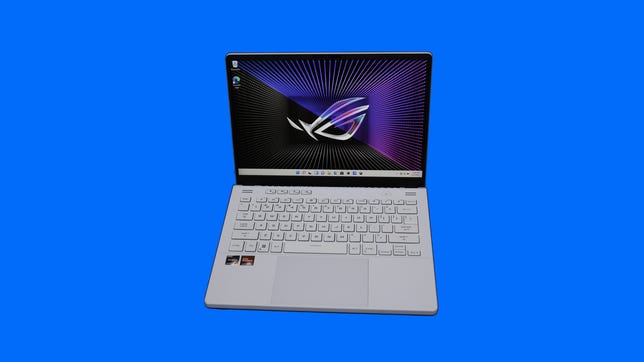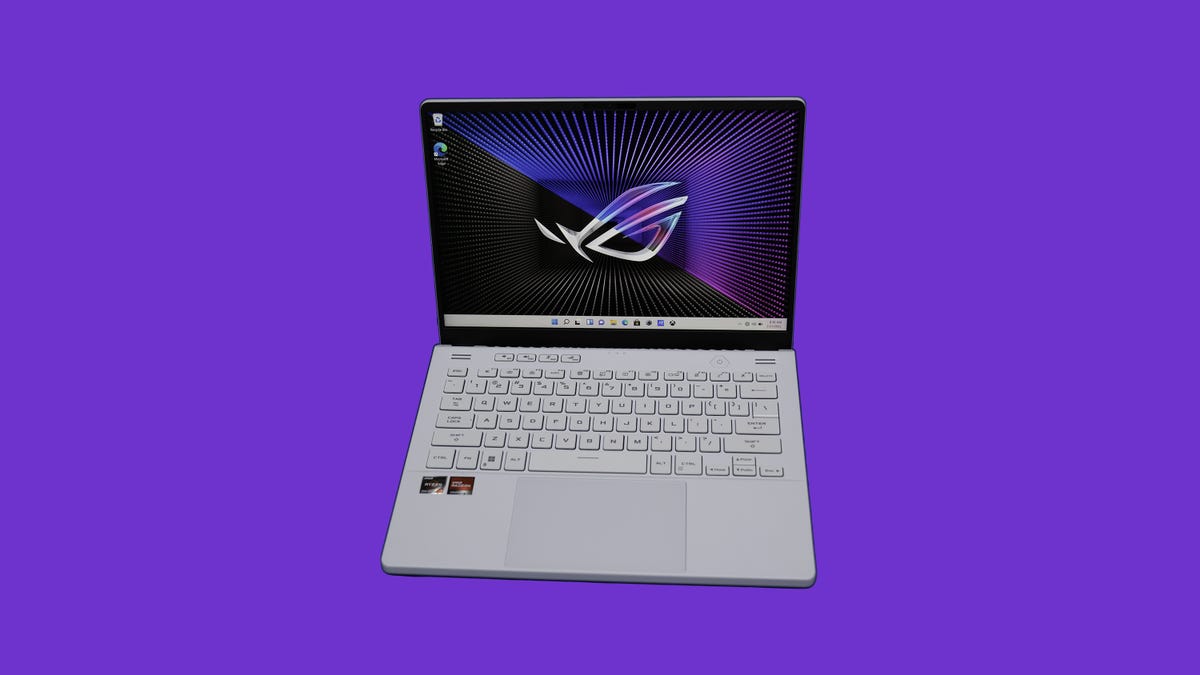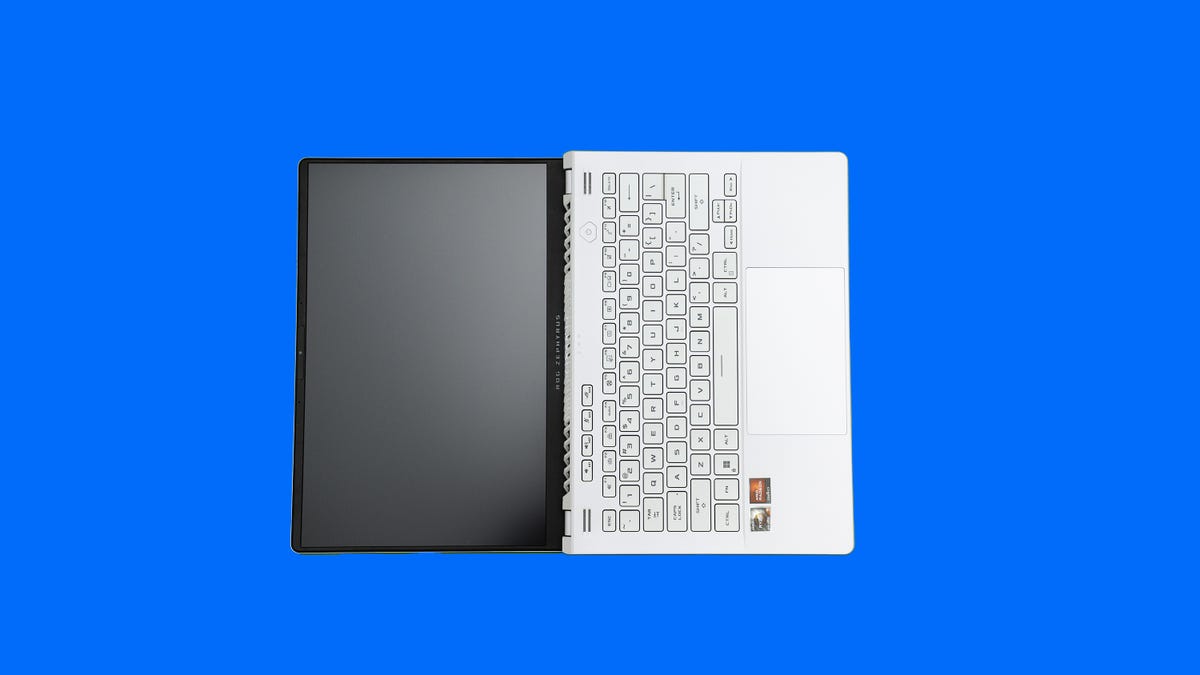Asus ROG Zephyrus G14 (2022) Review: Quick but Quirky

Mục Lục
Asus ROG Zephyrus G14 (2022)
$2,500 at Asus
Like
- Good plugged-in performance for its size
- Very nice 2,560×1,600 display
- Can open a full 180 degrees
Don’t like
- Some aspects of performance tank while running on battery
- Subpar webcam
- Have to reboot to switch to always-on discrete graphics, which is the only way to ensure the G14 is using it
The Asus ROG Zephyrus G14 for 2022 was the first system announced that would adhere to the 2022 version of AMD’s Advantage design framework, as the original G14 model did when it launched in 2020. That means it uses AMD’s latest technologies. This year, much of AMD’s chip updates aim to increase the battery life of gaming laptops while boosting performance by directing more power where and when it’s needed.
These include the Ryzen 9 6900HS low-power/high-performance processor for small gaming laptops and either the AMD Radeon RX 6700S or RX 6800S, graphics processors targeting the same low-power-yet-high-performance tier. But the catch seems to be it’s either-or: either high performance or low power. And that’s not just for graphics-intensive tasks, where I’d typically expect to see the tradeoff.

The other catch is availability. It’s already slipped from its initial March estimate, though that’s probably attributable to the current production and shipping-related supply chain shortages. But even before the pandemic these Asus and AMD poster-child laptops always seemed to have frustrating availability issues. The price for my evaluation configuration, which you can’t even preorder, is $2,500 (£2,000). There’s no official retail in Australia, but it seems to sell for about AU$3,499.
AMD’s worked hard to interconnect its CPU and GPU operation. So if Asus decides to release models with an Nvidia GPU — those tend not to have the same availability gaps — you won’t be able to make any assumptions about its speed, battery life or behavior on different power profiles based on the AMD versions. For instance, AMD’s SmartShift can juggle the power needs of the CPU and GPU to increase the power to the GPU from 80w to 105w, but only if both processors are AMD’s.
Asus ROG Zephyrus G14 GA402RK (2022)
Price as reviewed $2,500, £2,000Display 14-inch 2,560×1,600 120HzPC CPU 4.9GHz AMD Ryzen 9 6900HSPC Memory 32GB DDR5 SDRAM 4,800MHz (16GB soldered)Graphics 8GB AMD Radeon RX 6800SStorage 1TB SSD, micro SD slotPorts 2 x USB-C, 2 x USB-A 3.2, 1 x HDMI 2.0bNetworking MediaTek Wi-Fi 6E MT7922 (802.11ax/HE), Bluetooth 5Operating system Microsoft Windows 11 Pro 21H2Weight 3.8 lbs/1.7kg
Changes from previous models include the improved AniMe Matrix LED array on the cover. This cute but gimmicky animation feature bumps the overall weight from 3.6 to 3.8 pounds. Screen choices include a new 120Hz 1440p-class 500-nit screen with a full P3 color gamut, which I tested, though the default is a 1080p 450-nit 144Hz model. There are the other random design tweaks that constitute a more-than-rote refresh: The webcam now works with Windows Hello facial recognition sign-on but it’s still an underwhelming 720p camera. Asus also reorganized the speakers with upward-firing tweeters and downward-firing woofers.

Because the laptop’s display opens 180 degrees, you can adjust it to any angle you’d like.
I don’t remember enough about the older model to make a better-or-not judgment about the bigger touchpad, easier-to-open lid or more durable coating on the keycaps, but I can say the touchpad is a good size and feel, the lid opens singlehandedly and the keycaps feel premium. The white matte outer coating seems stainproof — or at least, the coffee I dripped on it came off easily even after drying.

The power connector is right in the middle of the left side which isn’t a terrific location.
As tested, the factory-calibrated screen has impressive color accuracy, covers 100% of the P3 gamut (only 88% Adobe RGB) and nails 2.2 gamma. Though it’s rated at 500 nits brightness, you’ll typically see a maximum of closer to 250, and it doesn’t support HDR for gaming — just Dolby Vision HDR, which has meager support in PC games at the moment.

The G14 has a big, smoothly operating touchpad and a solid-feeling keyboard. It doesn’t have a PrtSc key (which I use regularly for direct-to-disk screenshotting), but rebinding the keystrokes in Xbox Game Bar is a serviceable workaround.
When you discount performance, the G14 is above average, but not stellar. Once you get past the 14-inch size, decent display and AniMe Matrix LED, the rest is pretty typical. The laptop’s real story is in its performance, both good and bad.
Hit the gas
When it’s running at full power, plugged in and the discrete graphics processor always on, it’s fast for its size. In its default performance profile, the AMD Ryzen 9 6900HS performs roughly the same or a bit better as the Intel Core i9-12900H in the Zephyrus Flow Z13 (we’re still in preliminary testing on that, though) on multicore operations, but not quite as well on single core operations. It does fare well against the previous-generation high-power Ryzen 9 5900HX I tested in the ROG Strix G15 Advantage Edition.
But pulling the plug can result in a huge drop in processor speed using the default (Performance) profile — I saw it drop by almost 70% on general multicore speed on Geekbench 5. Even moderately demanding web apps (as measured by MotionMark and WebXPRT3) drop by between 20 and 50%. That’s because it automatically switches to its aggressive Silent power-and-sound management profile. It’s also the main reason battery life runs between 9 and 10 hours on an undemanding task such as streaming web video with the default profile.
The gap between the default profile and forcing it to use the discrete graphics processor is a lot bigger in some cases than I typically see when testing laptops. For example, when I played RiftBreaker, CPU performance in 1080p rose from 83.9fps to 95.8fps (14%) while GPU jumped from 211fps to 267fps (26%). On the other hand, when I ran SolidWorks at 1080p in SpecViewPerf 2020 I saw a negligible difference. The biggest bump was about 14% when I ran Maya.
If you didn’t have to reboot to switch from Hybrid to discrete GPU modes, it wouldn’t be such a pain. But you do. It’s not nearly as annoying as the Razer Blade 14, which could only force discrete GPU on if you connected it to an external display, but you don’t sacrifice as much if you don’t force it.
If you want to set it and forget it, unless you’re setting and forgetting while plugged in, this probably isn’t the system for you. AMD and Asus may have put all that work into making it “automatic,” but it’s still not automatic enough. It’s possible the curves just need some fine-tuning — though I retested with BIOS and profile settings in early April — or that I prioritize battery life a little lower than most. I’ll also note that it hasn’t shipped yet, so who knows what other optimizations will be made to the version that ships.
Geekbench 5 (multicore)
Asus ROG Zephyrus G14 (2022) on battery
4,826
Razer Blade 14 (2021)
7,277
Asus ROG Strix G15 Advantage Edition (G513QY)
7,569
Asus ROG Zephyrus G14 (2022)
10022
Asus ROG Flow Z13
11,620
Note: Longer bars indicate better performance
Cinebench R23 CPU (multicore)
Asus ROG Flow Z13
11028
Razer Blade 14 (2021)
11,554
Asus ROG Zephyrus G14 (2022)
13013
Asus ROG Strix G15 Advantage Edition (G513QY)
13,390
Note: Longer bars indicate better performance
Cinebench R23 CPU (single core)
Razer Blade 14 (2021)
1,442
Asus ROG Strix G15 Advantage Edition (G513QY)
1,495
Asus ROG Zephyrus G14 (2022)
1573
Asus ROG Flow Z13
1901
Note: Longer bars indicate better performance
Streaming video playback battery drain test (minutes)
Razer Blade 14 (2021)
480
Asus ROG Zephyrus G14 (2022)
566
Note: Longer bars indicate better performance
Shadow of the Tomb Raider gaming test (1080p)
Razer Blade 14 (2021)
88
Asus ROG Zephyrus G14 (2022)
92
Asus ROG Strix G15 Advantage Edition (G513QY)
102
Note: Longer bars indicate better performance (FPS)
3DMark Time Spy
Asus ROG Zephyrus G14 (2022)
7249
Asus ROG Zephyrus G14 (2022) with discrete GPU
9223
Razer Blade 14 (2021)
9,502
Asus ROG Strix G15 Advantage Edition (G513QY)
10,248
Note: NOTE: Longer bars indicate better performance
3DMark Fire Strike Ultra
Asus ROG Zephyrus G14 (2022)
5372
Asus ROG Zephyrus G14 (2022) with discrete GPU
6338
Razer Blade 14 (2021)
6,501
Asus ROG Strix G15 Advantage Edition (G513QY)
7,994
Note: Longer bars indicate better performance
SpecViewPerf 2020 SolidWorks (1080p)
Asus ROG Zephyrus G14 (2022) with discrete GPU
134.58
Asus ROG Strix G15 Advantage Edition (G513QY)
144.38
Razer Blade 14 (2021)
166.29
Note: Longer bars indicate better performance (FPS)
Configurations
Asus ROG Flow Z13 Microsoft Windows 11 Home (21H2); 2.5GHz Intel Core i9-12900H; 16GB LPDDR5 SDRAM 4,850MHz; 4GB Nvidia GeForce RTX 3050 Ti; 1TB SSDAsus ROG Strix G15 AMD Advantage Edition Microsoft Windows 10 Home (21H1); 3.3GHz AMD Ryzen 9 5900HX; 16GB DDR4 SDRAM 3,200MHz; 12GB AMD Radeon RX 6800M; 512GB SSDAsus ROG Zephyrus G14 GA402RK (2022) Microsoft Windows 11 Pro (21H2); 4.7GHz AMD Ryzen 9 6900HS; 32GB DDR5 SDRAM 4,800MHz; 8GB AMD Radeon RX 6800S; 1TB NVMe SSDRazer Blade 14 (2021) Microsoft Windows 10 Pro (21H1); 3.3GHz AMD Ryzen 9 5900HX; 16GB DDR4 SDRAM 3,200MHz; 8GB Nvidia GeForce RTX 3080; 1TB SSD






